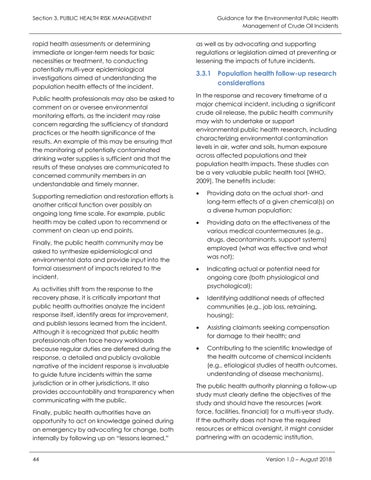Section 3. PUBLIC HEALTH RISK MANAGEMENT
rapid health assessments or determining immediate or longer-term needs for basic necessities or treatment, to conducting potentially multi-year epidemiological investigations aimed at understanding the population health effects of the incident. Public health professionals may also be asked to comment on or oversee environmental monitoring efforts, as the incident may raise concern regarding the sufficiency of standard practices or the health significance of the results. An example of this may be ensuring that the monitoring of potentially contaminated drinking water supplies is sufficient and that the results of these analyses are communicated to concerned community members in an understandable and timely manner. Supporting remediation and restoration efforts is another critical function over possibly an ongoing long time scale. For example, public health may be called upon to recommend or comment on clean up end points. Finally, the public health community may be asked to synthesize epidemiological and environmental data and provide input into the formal assessment of impacts related to the incident. As activities shift from the response to the recovery phase, it is critically important that public health authorities analyze the incident response itself, identify areas for improvement, and publish lessons learned from the incident. Although it is recognized that public health professionals often face heavy workloads because regular duties are deferred during the response, a detailed and publicly available narrative of the incident response is invaluable to guide future incidents within the same jurisdiction or in other jurisdictions. It also provides accountability and transparency when communicating with the public. Finally, public health authorities have an opportunity to act on knowledge gained during an emergency by advocating for change, both internally by following up on “lessons learned,” 44
Guidance for the Environmental Public Health Management of Crude Oil Incidents
as well as by advocating and supporting regulations or legislation aimed at preventing or lessening the impacts of future incidents.
3.3.1 Population health follow-up research considerations In the response and recovery timeframe of a major chemical incident, including a significant crude oil release, the public health community may wish to undertake or support environmental public health research, including characterizing environmental contamination levels in air, water and soils, human exposure across affected populations and their population health impacts. These studies can be a very valuable public health tool [WHO, 2009]. The benefits include: •
Providing data on the actual short- and long-term effects of a given chemical(s) on a diverse human population;
•
Providing data on the effectiveness of the various medical countermeasures (e.g., drugs, decontaminants, support systems) employed (what was effective and what was not);
•
Indicating actual or potential need for ongoing care (both physiological and psychological);
•
Identifying additional needs of affected communities (e.g., job loss, retraining, housing);
•
Assisting claimants seeking compensation for damage to their health; and
•
Contributing to the scientific knowledge of the health outcome of chemical incidents (e.g., etiological studies of health outcomes, understanding of disease mechanisms).
The public health authority planning a follow-up study must clearly define the objectives of the study and should have the resources (work force, facilities, financial) for a multi-year study. If the authority does not have the required resources or ethical oversight, it might consider partnering with an academic institution, Version 1.0 – August 2018







